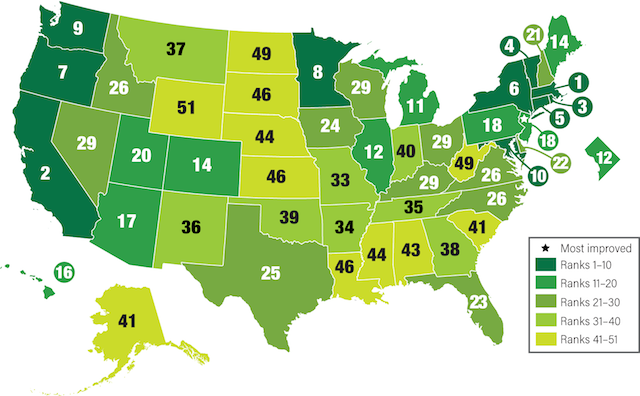Massachusetts, California and Rhode Island come out on top in the 2018 State Energy Efficiency Scorecard released this fall. The three states ranked high on six categories including utility programs, transportation, building energy codes, combined heat and power, state initiative and appliance standards, according to the American Council for an Energy Efficient Economy (ACEEE). Of those categories, advancing building energy codes are one of the most impactful actions that states can take to meet energy and carbon reduction goals.
And while the leaders have held these top spots for years now, there are four new states worth noting that have made great progress in commercial building codes since last year’s Scorecard was released. Michigan, Florida, Wisconsin and Idaho all saw code improvements that bettered their ACEEE scores in that area. To improve their commercial energy code performance scores, those four states adopted the 2015 International Energy Conservation Code (IECC) improving the expected energy stringency of new construction projects, resulting in lower energy use and higher energy efficiency.
Determination of points related to energy codes in this year’s Scorecard was based on a new approach utilizing the zEPI Jurisdictional Scores developed for this purpose by NBI. zEPI stands for zero energy performance index (zEPI) and the score intends to address the growing number of states looking to drive local building stock toward zero energy (ZE) performance—that is buildings that produce as much energy as they use over the course of a year, with performance achieved through energy efficiency and renewable technologies. While not all states will achieve zero energy codes, pushing against stagnated code stringency is a critical focus for states to improve.
To develop a common baseline against which the energy performance of code-compliant buildings can be compared across states, NBI has applied the zEPI scale to create the zEPI Jurisdictional Score. This method uses a framework for calculating scores for entire states based on their adopted energy policy, and taking into account statewide energy codes and local stretch codes. By leveraging new code analysis published by Pacific Northwest National Labs and combining it with NBI’s in-house policy tracking work, our analysts calculated zEPI Jurisdictional Scores for every state with adopted energy codes, and for others without a statewide code which have sufficient data available on local adoptions.
With the zEPI scale, fair comparisons can be made between different code levels, climate zones, and building types. By fixing the baseline to CBECS 2003 performance levels (zEPI 100) and the goal to net zero (zEPI 0), we create a linear scale which can be used to track progress towards zero. ACEEE transitioned to the zEPI Jurisdictional Score as the new basis for assigning energy code points in their State Scorecard. With their common goal of “zero,” the zEPI scores provide ongoing tracking of progress toward zero energy goals. See the chart for how the top 10 state residential and commercial codes currently rank on the zEPI scale, based on adopted codes effective as of January 2017, which a few exceptions for states that had more recent adoptions.

With a metric that gives a clear vision to zero energy, tracking the zEPI rankings of energy code models and jurisdictional adoption will provide straightforward feedback to policymakers and a variety of stakeholders on how they are progressing toward a low-energy, low-carbon future.
by Kevin Carbonnier, Project Manager
